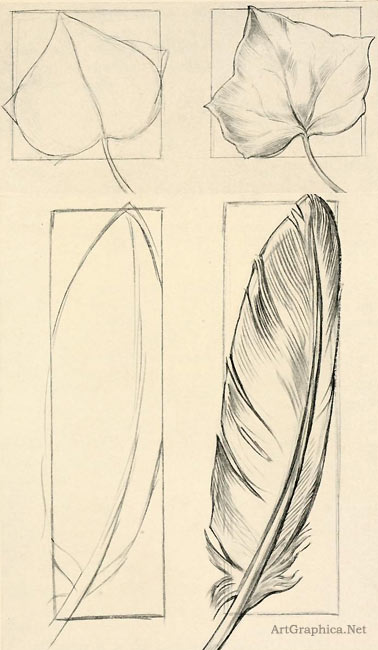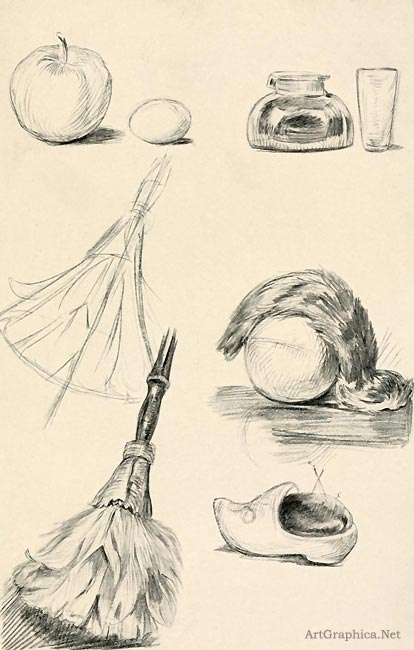How to Learn Drawing
CHAPTER I
How to Begin. Simple Subjects for Drawing and Painting
Do you like painting ? Does drawing interest you ? Have you a pencil, a box of chalks, or a paint-box ? Because, if you have even one of these things, you can open the door to such jolly times.
Do you remember Alice finding in Wonderland the little closed door, and how she longed to open the door and walk into the charming garden ? Well, there's a garden just as fascinating as the one seen by Alice, and the keys to it are your pencil and brush.
This garden, like Alice's, is full of wonderful surprises. You never know what is lying in wait, what quaint, curious, and beautiful things are to be found. Would you like to go into it ? Then come with me. You have the keys in your hands.
But first I will ask you a question. Have you ever heard of the story of the shepherd-boy of Vespignano ?
Once upon a time there lived in Italy a little shepherd-boy who was so passionately fond of drawing that he would pick up a stick and draw with it on the dusty roads and sandy rocks.
You might ask why he used such rough tools ; it was all the material he could call his own. Paper and parchment were far beyond the reach of shepherd-boys. But Giotto, for that was his name, drew quite happily with his pointed stick upon the ground, and he had all the hillside from which to choose his subjects. He drew the flowers, the grass, and the pine-trees. Best of all, he liked to draw his sheep, and these he drew with loving care. A great artist called Cimabue happened to pass one day when Giotto was absorbed in his drawing. His curiosity was awakened, and dismounting from his horse he drew near. To his unbounded surprise he saw, traced on the ground, a number of beautiful little sketches.
He began to talk with Giotto, and soon discovered that the boy's whole soul was in his simple art. And, being a wise and very generous man, he determined to do all that lay in his power to educate Giotto as an artist. In a very little time the shepherd-boy left Vespignano for Florence, where he entered the great man's studio. Being extraordinarily gifted and more than usually industrious, he made rapid progress in his art. He soon outstripped his master, and in course of time was acclaimed the foremost artist of his day.
And that is the story of Giotto, who died ten years after Edward III came to the English throne.
IC Young people (and sometimes old people are not much
wiser) are fond of excusing their laziness by saying, " I can't draw this--or I can't draw that. I haven't got the materials, or the pencil won't work." Which last excuse is about as reasonable as mounting a push-bicycle and expecting it to carry you up a hill without your moving your legs.
The shepherd-boy taught himself by drawing with a pointed stick on a smooth piece of ground. So lack of materials is no excuse for lack of effort.
One of my young readers may cry, " Draw ! Draw ! I draw ? Why, I cannot draw a straight line." As a matter of fact, a perfectly straight line is one of the most difficult things to draw. There are many artists who cannot easily draw a straight line. If you study Nature--and she is our safest guide--you will never see an absolutely straight line. If you do see one, you may be sure that the hand of man has helped to make it.
A very general excuse is that which pleads the impossibility of drawing two sides of an object alike. Have you ever seen two ' sides ' alike in Nature--a tree, a flower, or even a single blade of grass, inch by inch and tint by tint, the same ? Look round and judge for yourself.
Only man makes things mathematically exact. He is forced to balance one side with the other side. The cup, the vase, the house, will not stand and support itself. Nature is bound by no such rules, and Nature is always an artist.
Would you like to know the most difficult thing of all to draw ? Without question, a perfect circle.
Strangely enough there was one artist whose fortune was made through the drawing of a circle. It was Giotto, the shepherd-lad whose story we have just been discussing. When his name was beginning to be known the Pope sent to learn more about him. He wished to employ the cleverest artist to be found in all Italy to paint pictures on the walls of the great church of St Peter at Rome.
And how do you think Giotto convinced the envoys of his fitness for the work ? He took a large sheet of paper, and, dipping his brush into red paint, he drew a circle with one sweep of his arm, perfect and exact.
" Take that to the Pope," he said.
And the Pope admitted that of all the paintings submitted by the artists not one equalled the perfection of Giotto's O ; whence we have the proverb, " As round as Giotto's O," signifying perfection.
We are not, unfortunately, all Giottos. Straight lines, symmetrical sides, perfect circles--perhaps when we are older we shall be able to attack these problems without flinching, but now, away with them and away with all excuses--let us begin drawing.
Take a sheet of paper, or open your sketch-book ; pick up a pencil. Now what shall we draw ?
Some children bubble with odd fancies ; men, horses, fairies, dogs come tripping to their minds ; but you and I are not so sure. We will choose something simple, something interesting.
What of a leaf, an ivy leaf ?--for that we can easily find whether we live in city or country.
It is a quaint shape when we come to observe it closely. Would you call it a long, square, or round shape ? I should say that it resembled a heart.
Then we will draw a heart-shape. Next we see a large vein running through the centre of the heart. It extends from the very tip of the leaf to the stout little stalk which eventually fastens itself on to the main branch.
Now we had better mark the chief points of our leaf, which are three in number. And also there arc two or three a trifle smaller. These we also draw. And we note that the large central vein is met by two smaller veins, and that these, with two more, radiate from the stalk.
Turn the leaf and look at its back and see how wonderfully these veins converge to the stalk.
Put in some of the veins lightly and carefully, choosing the biggest and the most important.
Next we should note that the light comes from one side, and the side farthest from the light is in shadow. We might shade the edges of the leaf with our pencil and sharpen and shade the strongly curved stalk, and any other part that needs to be strengthened.
You may say that you live where there are no ivy leaves. Then take a maple leaf, a sycamore, or a chestnut ; any leaf at hand. I am not laying down any hard-and-fast rules, but merely trying to help you with something that you want to do.
If you prefer it, draw a shell or a feather. I suggest these particular things because they are simple and easy to draw, and within the reach of most people.
A feather can be studied on the same lines as a leaf, presuming that it is a well-formed wing or tail feather--a not-toofluffy affair. First observe its general shape. Elongated-- oblong, is it not ? Then draw in an oblong shape. Next notice that it is broad at the bottom end, and that it inclines to a rounded point. We will shape off the side tips.
Next we trace the main stalk or stem from which the plume spreads. Observe the separating of the plume on one side, the crisp firmness of the narrower vein, the fluffiness at the back of the thick stem, and the solid firmness of the stem itself.
We can work this with a pencil and trace the beautiful marking on the feather, or we can produce our paint-box and try to colour our drawing. It is an excellent plan to hide the model from sight, and see how much, or how little, has penetrated our brain.
Afterward try drawing some simple flowers : a snowdrop in a small vase ; a crocus--bulb, stem, and flower ; a daffodil with a few broad spear-like leaves.
And if we find it difficult to interpret shapes with our pencil, and our brain tires, and our fingers get weary, choose some very different and opposite' shapes.
The mere task of choosing requires a little stimulating reflection.
For instance, contrast a flat, squat-shaped, circular ink pot with a small, narrow upright tumbler ; a big spoon w.th a broad-handled knife. Compare a lemon with a tangerine ; an egg with an apple ; a reel of cotton with a tube of water-colour paint ; a matchbox with an ash-tray ; a tall slender vase and a dumpy bowl ; a large breakfast-cup and a small cocoa-tin ; a flat, thin book and a sphere-shaped paper-weight.
Put some of these objects on a table, at a little distance from your desk, and sketch them two by two, and side by side.
You could draw some with your pencil, and some with your brush.
The lemon and the tangerine are excellent subjects for this test, because you have contrast of both shape and colour.
If you sketch them first with your brush, choose a tint of which they are both composed--say, a very pale yellow.
Draw first the lemon, the large, elongated, egg-shaped variety. Notice the characteristic knob, like a nose, at one end, and compare this with the round tangerine and its somewhat flattened top. You will find a further interest in comparing colours. How rich is the orange tinge beside paler yellow ! How deep the shadows of the tangerine appear when compared with those of the lighter-hued lemon ! For the lemon we must seek out our cool blues and pale golds ; for the tangerine, warm crimson, and even touches of bronze and brown.

Fig. 3. IVY' LEAF AND FEATHER
If we wish to handle our pencils intelligently (to get from our pencil many varied touches), we should draw objects which are variously composed. In other words, made of more than one material. And here again we must don our thinking-cap.
We need not go very far. A few homely domestic articles would furnish us with some useful models.
Take a feather brush--that is, a brush composed of feathers, leather, and smooth polished wood ; hang this up at a level with your eye, feathers downward, and sketch it with your pencil.
Draw a long line to represent the handle, and indicate the rough fan-shape of the lower part. If the handle is grooved and turned, do not worry because you cannot get both sides exactly alike. First sketch the largest shapes and remember to keep the stick slender ; next the three-cornered piece of leather which neatly hides and binds the ends of the feathers together ; lastly, the feathers themselves, spreading out in a loose, plumy fan.
Having sketched these shapes, darken the handle, which is polished and black. Leave the white paper to show through to provide the lights. Try to represent the polish of the surface by drawing with firm sharp touches.
The leather, being of a more pliable material and of a duller surface, needs a lighter treatment. If it has a dull tint, give it a shaded tone ; if it has folds, draw these folds in shadow.
Next the feathers.
A feather is one of the lightest of all substances. We say " light as a feather " when we wish to suggest something of the airiest description.
But although it is so unsubstantial, it is not feeble. It has a definite shape.
Each feather has a spine from which it spreads in a definite shape. Soft, yes, and delicate, but with a curved spine and a broad tip. Look at those nearest to you . . . and draw their shapes delicately. Hold your pencil lightly, give a gentle, feathery touch, and, as the feathers are bunched together, and some will be in shadow, put in the shadows lightly, but sharply. Then pause and look at your drawing.
Have you ' handled' the drawing of the wood and the feathers differently ? Does the leather look more substantial than the feathers ?
The work is not easy, but practice will soon give a surer touch. You are playing a scale with your pencil as one plays a scale on a piano. Deep bass notes, then the middle strong notes, and lastly the soft delicate treble. We must try to make our pencil speak with a varied tongue.
Drawing different textures might include a kettle and a kettle-holder (shiny metal--rough cloth or velvet) ; a small piece of fur coiled near, or over, a hard cricket-ball ; a cake of soap and a loofah. A woman's hat with a soft wide brim (not the pudding basin variety, which is most difficult for unpractised fingers), trimmed with a cluster of berries, or a twisted bow of ribbon, gives us several different textures.
We must hold the pencil delicately, loosely, and half-way up the shaft if we wish to convey the delicacy of fur and fine hairs. If we would show the richness of velvet, we must use our pencil with determination and shift our fingers for a shorter and firmer grip.
All this will come with practice. There is no need to worry yourself with harassing doubts. Do your best ; no one can do more.
When we work alone, we are very apt to get weary and depressed with our difficulties.
We sit before our little models and look so often that we see less and less, instead of more and more.
It is very wise occasionally to cover up your model, or, at any rate, to turn your back upon it for a while.
This will often appear to increase your difficulties, but it will tend to quicken your observation, and this is worth any extra trouble or discouragement that may be entailed. There is a temptation to look continually at our models, and in consequence we look at them more often than is necessary.
If, after looking at the model, we hide it from sight and then proceed with our drawing, obviously we must work from memory. The habit of working without models is soon developed, and it adds enormously to our powers of ' taking notice.'

Fig. 4. MODELS ILLUSTRATING VARIED SHAPES AND TEXTURES
Prev. Page
Drawing for Beginners
|










